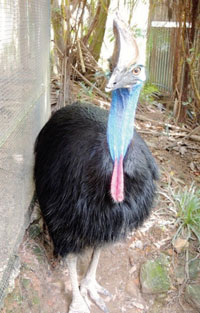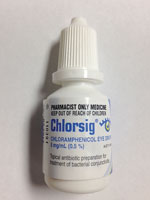  |
Readers familiar with this column have, at times, seen me comment upon ocular therapeutic issues that I have gleaned while traveling abroad. I recently returned from lecturing at the Tasmania Lifestyle Congress in Hobart, Tasmania off the coast of Australia. This is one of the finest conferences that I have ever attended, and it was a pleasure and an honor to be invited to present.
My epiphany for this column did not come from the actual conference, but rather from touring Australia. At one wildlife park, I had the chance to hold a koala. It was a wonderful experience, but when I put this hairy-bowling-ball-with-claws down, I noticed that I was covered with the scent of eucalyptus. Koalas are herbivorous and most of their diet consists of eucalypt leaves. The oils seep from their pores and coat their fur, giving koalas that distinct eucalyptus scent.
I found myself reflecting upon how many natural compounds have found their way into modern medicine. The eucalyptus oil used by humans comes from Eucalyptus, a diverse genus of flowering trees and shrubs. The oil is steam-distilled from the plant’s leaves and has many uses, such as an industrial solvent, antiseptic, decongestant to open clogged nasal passages, and is used in some foods such as cough drops.
There are numerous home remedies, potions, lotions and alternative therapies that are often discounted by modern medicine. However, some natural products do indeed have medicinal properties. Considering where some commonly used ophthalmic medications have arisen from, it would not be wise to totally discount natural therapies.
 | |
| The author and his wife, Lori Vollmer, OD, making friends in Australia. |
From a Shrubbery
Pilocarpine is a parasympathomimetic medication that works topically to lower intraocular pressure (IOP) in glaucoma and orally to increase saliva production in patients with xerostomia. In the eye, it causes constriction of the iris sphincter muscle, resulting in pupillary miosis. In angle-closure patients, the miotic effect can move the pupil off the mid-dilated state where pupil block is most pronounced, as well as physically stretch the iris, pulling it away from the pigmented trabecular meshwork. In open-angle situations, the iris contraction puts stress on the scleral spur, temporarily altering the structure of the trabecular meshwork, allowing aqueous to flow better through this drainage pathway.
Few know our oldest topical glaucoma treatment, topical pilocarpine, is obtained from the leaves of tropical South American shrubs from the genus Pilocarpus. Commercial production is derived entirely from the leaves of Pilocarpus microphyllus. Topically applied pilocarpine is extracted from powdered leaf material in a multi-step process involving acidification, ammonification and chloroform extraction.
A Good Nightshade
Topically applied atropine is an anticholinergic medication that blocks the neurotransmitter acetylcholine at the muscarinic receptors of the neuromuscular junction. Atropine is in the belladonna alkaloid family and has been used for hundreds of years to cosmetically enlarge the pupils. Atropine has numerous systemic uses. It can be used to treat symptomatic bradycardia as well as reduce salivation and sweating. By blocking the action of acetylcholine, atropine can be used as a treatment for poisoning by organophosphate insecticides and nerve gases.
In the eye, topically applied atropine will induce mydriasis and cycloplegia by blocking acetylcholine at the nerve junctions in the pupil sphincter and ciliary body, respectively. Due to atropine’s long duration of action, it is not a preferred mydriatic agent, but its deep penetration and full blocking effects makes it an extremely useful cycloplegic agent in uveitis management.
Visual blur induced by atropine makes it a useful alternative to patching in amblyopia therapy.
While we are accustomed to atropine in a bottle as a topical solution, it occurs naturally in a number of plants of the nightshade family, including deadly nightshade, Jimson weed and mandrake. I recall a patient who accidentally cyclopleged herself for two weeks by handling the wrong plant at a flower show.
 | |
| The cassowary may look like a rough customer, but she’s actually quite harmless. The same is true of some ophthalmic medications. |
Power Plants
Mirtogenol (LifeExtension) is a combination formula of a bilberry extract called Mirtoselect and Pycnogenol French maritime pine bark extract. It is a non-prescription supplement promoted to both increase ocular blood flow as well as reduce IOP in patients with glaucoma and ocular hypertension.
In a blood flow study, 38 subjects with ocular hypertension were either given Mirtogenol (20 subjects) or were not treated (18 subjects).1 The visual acuity, IOP and ocular blood flow were measured at two, three and six months. Nineteen of the 20 patients taking Mirtogenol had a decreased IOP after three months. Based upon color doppler imaging, ocular blood flow in the central retinal, ophthalmic and posterior ciliary arteries significantly (p<0.05) increased both in the systolic and diastolic components, as compared with both the baseline and control groups.1
In an IOP study of Mirtogenol’s effects, 79 patients with ocular hypertension were randomly assigned to three groups to receive either Mirtogenol, latanoprost or both in combination. Mirtogenol lowered IOP in patients almost as effectively as latanoprost, though it took much longer (24 weeks vs. four weeks) to do so. Mirtogenol alone lowered IOP from baseline 38.1mm Hg to 29mm Hg after 16 weeks, whereas latanoprost alone lowered IOP from baseline 37.7mm Hg to 27.2mm Hg within four weeks. Mirtogenol potentiated the IOP lowering effect of latanoprost; the combination of latanoprost and Mirtogenol was more effective for lowering IOP than either alone. The combination of Mirtogenol/latanoprost lowered IOP from 38mm Hg to 27.3mm Hg after four weeks, and further decreased IOP to 24.2mm Hg after six weeks.2
Mirtogenol has shown promise in these small studies, but since it appears no further research has been conducted on this product, I do not actively recommend this product. However, I will discuss the known research with patients who ask about natural and over-the-counter adjuncts for glaucoma treatment.
While it is easy to dismiss products made from barks, plants, extracts, seeds and the like, it is important to remember that some of these so-called natural products can have valuable medicinal properties. Some of these remedies have even undergone professional compounding and rigorous scientific scrutiny and have been approved and classified as medicines. Really, the only difference between a home potion or remedy and a medicine is approval by the FDA.
 | |
| Like the cassowary, chloramphenicol is behind only two known deaths. |
Which Has Killed More People: Cassowaries or Chloramphenicol?
No column based upon travels to Australia is complete without my usual chloramphenicol diatribe. Chloramphenicol has a broad spectrum of both gram-positive and gram-negative antibacterial activity.3-7 Since the inception of systemic chloramphenicol, there has been a reported association with several blood dyscrasias, the most notable of which is aplastic anemia. While topical chloramphenicol use is widespread throughout the world, this possible association with aplastic anemia has curtailed use of the drug in the United States. Practitioners have long known that this topical medication has resulted in patient deaths and fear the lethal potential of topical chloramphenicol.3-7 But how deadly is this drug?
Stories of the deadly potential from topical chloramphenicol are similar to those I have always heard, and believed, about the ‘world’s most dangerous bird,’ the Australian cassowary, a large emu-like flightless bird with strong claws. Every time I have been in Australia, I have heard about this bird’s ability (even proclivity) to kill humans. However, during my most recent trip, a biologist actually gave me the facts about the “world’s most dangerous bird.” Apparently, during the approximately 200 years that the species has been recognized, only two people have been killed, presumably in defense of a nest or young (W61.92. is the ICD-10 code for this, by the way). This actually approximates the number of people who have been killed by topical chloramphenicol. The first case of aplastic anemia associated with topical use was reported in the 1960s.8 In 1980 and 1982, the first two cases of fatal aplastic anemia that were thought to be associated with topical chloramphenicol use were reported.9,10 While chloramphenicol has not been used in the United States for many years due to perceived risks of aplastic anemia, the Australians have no such worries; topical chloramphenicol is over-the-counter in Australia. In fact, I walked into a pharmacy and bought myself a bottle to take home.
1. Steigerwalt RD, Gianni B, Paolo M, et al. Effects of Mirtogenol on ocular blood flow and intraocular hypertension in asymptomatic subjects. Mol Vis. 2008;14:1288-92.2. Steigerwalt RD Jr, Belcaro G, Morazzoni P, et al. Mirtogenol potentiates latanoprost in lowering intraocular pressure and improves ocular blood flow in asymptomatic subjects. Clin Ophthalmol. 2010;4:471-6.
3. Usha K, Smitha S, Shah N, et al. Spectrum and the susceptibilities of microbial isolates in cases of congenital nasolacrimal duct obstruction. J AAPOS. 2006;10(5):469-72.
4. Matuska S, Rama P, Cavallero A, et al. Nocardia keratitis: a case report. Eur J Ophthalmol. 2006;16(1):164-7.
5. Arantes TE, Cavalcanti RF, Diniz Mde F, et al. Conjunctival bacterial flora and antibiotic resistance pattern in patients undergoing cataract surgery. Arq Bras Oftalmol. 2006;69(1):33-6.
6. Orden Martínez B, Martínez Ruiz R, Millán Pérez R. Bacterial conjunctivitis: most prevalent pathogens and their antibiotic sensitivity. An Pediatr (Barc). 2004;61(1):32-6.
7. Robert PY, Adenis JP. Comparative review of topical ophthalmic antibacterial preparations. Drugs. 2001;61(2):175-85.
8. Lam RF, Lai JS, Ng JS, et al. Topical chloramphenicol for eye infections. Hong Kong Med J. 2002;8(1):44-7.
9. Fraunfelder FT, Bagby GC Jr, Kelly DJ. Fatal aplastic anemia following topical administration of ophthalmic chloramphenicol. Am J Ophthalmol. 1982;93(3):356-60.
10. Abrams SM, Degnan TJ, Vinciguerra V. Marrow aplasia following topical application of chloramphenicol eye ointment. Arch Intern Med. 1980;140(4):576-7.

